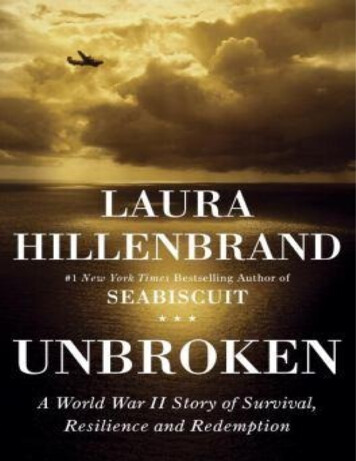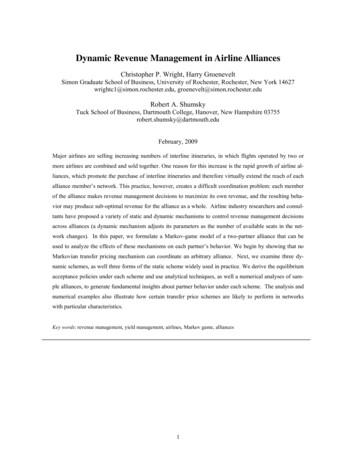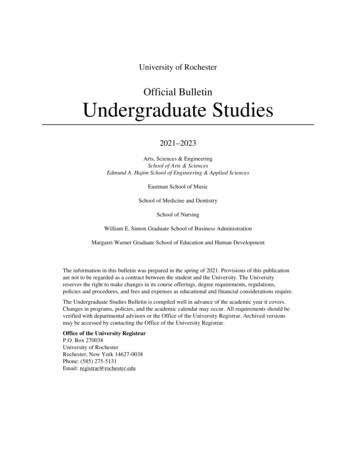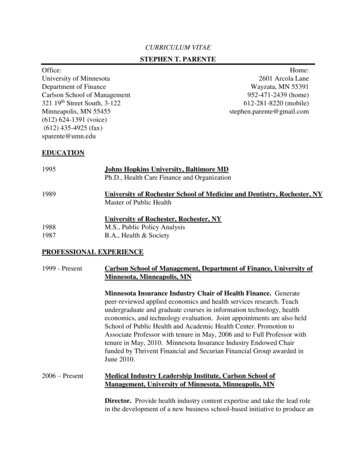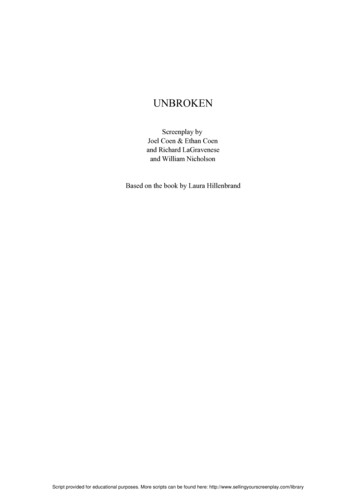
Transcription
Also by Laura HillenbrandSEABISCUIT
Copyright 2010 by Laura HillenbrandAll rights reserved.Published in the United States by Random House, an imprint of The Random House Publishing Group,a division of Random House, Inc., New York.RANDOM HOUSE and colophon are registered trademarks of Random House, Inc.LIBRARY OF CONGRESS CATALOGING-IN-PUBLICATION DATAHillenbrand, Laura.Unbroken : a World War II story of survival, resilience, and redemption / Laura Hillenbrand.p. cm.eISBN: 978-0-679-60375-71. Zamperini, Louis, 1917– 2. World War, 1939–1945—Prisoners and prisons, Japanese. 3.Prisoners of war—United States—Biography. 4. Prisoners of war—Japan—Biography. 5. WorldWar, 1939–1945—Aerial operations, American. 6. World War, 1939–1945—Campaigns—PacificArea. 7. United States. Army Air Forces. Heavy Bombardment Group, 307th. 8. Long-distancerunners—United States—Biography. I. Title.D805.J3Z364 2010 940.54′7252092—dc22[B] 2010017517www.atrandom.comv3.1
For the wounded and the lost
What stays with you latest and deepest? of curious panics,Of hard-fought engagements or sieges tremendous what deepest remains?—Walt Whitman, “The Wound-Dresser”
CONTENTSCoverOther Books by This AuthorTitle PageCopyrightDedicationMapEpigraphPrefacePART IChapter 1. The One-Boy InsurgencyChapter 2. Run Like MadChapter 3. The Torrance TornadoChapter 4. Plundering GermanyChapter 5. Into WarPART s”Chapter 8. “Only the Laundry Knew How Scared I Was”Chapter 9. Five Hundred and Ninety-four HolesChapter10.TheStinkingSixChapter 11. “Nobody’s Going to Live Through This”PART IIIChapter 12. DownedChapter 13. Missing at SeaChapter14.ThirstChapter 15. Sharks and BulletsChapter 16. Singing in the CloudsChapter 17. TyphoonPART IVChapter 18. A Dead Body BreathingChapter 19. Two Hundred Silent MenChapter 20. Farting for HirohitoChapter21.BeliefChapter 22. Plots Afoot
Chapter 23. MonsterChapter 24. HuntedChapter 25. B-29Chapter 26. MadnessChapter 27. Falling DownChapter 28. EnslavedChapter 29. Two Hundred and Twenty PunchesChapter 30. The Boiling CityChapter 31. The Naked StampedeChapter 32. Cascades of Pink PeachesChapter 33. Mother’s DayPART VChapter 34. The Shimmering GirlChapter 35. Coming UndoneChapter 36. The Body on the MountainChapter 37. Twisted RopesChapter 38. A Beckoning WhistleChapter 39. DaybreakEpilogueAcknowledgmentsNotesAbout the Author
PREFACEALL HE COULD SEE, IN EVERY DIRECTION, WAS WATER . It was June 23, 1943. Somewhere on theendless expanse of the Pacific Ocean, Army Air Forces bombardier and Olympic runner LouieZamperini lay across a small raft, drifting westward. Slumped alongside him was a sergeant, one of hisplane’s gunners. On a separate raft, tethered to the first, lay another crewman, a gash zigzagging acrosshis forehead. Their bodies, burned by the sun and stained yellow from the raft dye, had winnowed downto skeletons. Sharks glided in lazy loops around them, dragging their backs along the rafts, waiting.The men had been adrift for twenty-seven days. Borne by an equatorial current, they had floated atleast one thousand miles, deep into Japanese-controlled waters. The rafts were beginning to deteriorateinto jelly, and gave off a sour, burning odor. The men’s bodies were pocked with salt sores, and theirlips were so swollen that they pressed into their nostrils and chins. They spent their days with their eyesfixed on the sky, singing “White Christmas,” muttering about food. No one was even looking for themanymore. They were alone on sixty-four million square miles of ocean.A month earlier, twenty-six-year-old Zamperini had been one of the greatest runners in the world,expected by many to be the first to break the four-minute mile, one of the most celebrated barriers insport. Now his Olympian’s body had wasted to less than one hundred pounds and his famous legs couldno longer lift him. Almost everyone outside of his family had given him up for dead.On that morning of the twenty-seventh day, the men heard a distant, deep strumming. Every airmanknew that sound: pistons. Their eyes caught a glint in the sky—a plane, high overhead. Zamperini firedtwo flares and shook powdered dye into the water, enveloping the rafts in a circle of vivid orange. Theplane kept going, slowly disappearing. The men sagged. Then the sound returned, and the plane cameback into view. The crew had seen them.With arms shrunken to little more than bone and yellowed skin, the castaways waved and shouted,their voices thin from thirst. The plane dropped low and swept alongside the rafts. Zamperini saw theprofiles of the crewmen, dark against bright blueness.There was a terrific roaring sound. The water, and the rafts themselves, seemed to boil. It wasmachine gun fire. This was not an American rescue plane. It was a Japanese bomber.The men pitched themselves into the water and hung together under the rafts, cringing as bulletspunched through the rubber and sliced effervescent lines in the water around their faces. The firingblazed on, then sputtered out as the bomber overshot them. The men dragged themselves back onto theone raft that was still mostly inflated. The bomber banked sideways, circling toward them again. As itleveled off, Zamperini could see the muzzles of the machine guns, aimed directly at them.Zamperini looked toward his crewmates. They were too weak to go back in the water. As they laydown on the floor of the raft, hands over their heads, Zamperini splashed overboard alone.Somewhere beneath him, the sharks were done waiting. They bent their bodies in the water andswam toward the man under the raft.
Courtesy of Louis Zamperini. Photo of original image by John Brodkin.
OneThe One-Boy InsurgencyIN THE PREDAWN DARKNESS OF AUGUST 26, 1929, IN THE back bedroom of a smallhouse in Torrance,California, a twelve-year-old boy sat up in bed, listening. There was a sound coming from outside,growing ever louder. It was a huge, heavy rush, suggesting immensity, a great parting of air. It wascoming from directly above the house. The boy swung his legs off his bed, raced down the stairs,slapped open the back door, and loped onto the grass. The yard was otherworldly, smothered inunnatural darkness, shivering with sound. The boy stood on the lawn beside his older brother, headthrown back, spellbound.The sky had disappeared. An object that he could see only in silhouette, reaching across a massivearc of space, was suspended low in the air over the house. It was longer than two and a half footballfields and as tall as a city. It was putting out the stars.What he saw was the German dirigible Graf Zeppelin. At nearly 800 feet long and 110 feet high, itwas the largest flying machine ever crafted. More luxurious than the finest airplane, gliding effortlesslyover huge distances, built on a scale that left spectators gasping, it was, in the summer of ’29, thewonder of the world.The airship was three days from completing a sensational feat of aeronautics, circumnavigation ofthe globe. The journey had begun on August 7, when the Zeppelin had slipped its tethers in Lakehurst,New Jersey, lifted up with a long, slow sigh, and headed for Manhattan. On Fifth Avenue that summer,demolition was soon to begin on the Waldorf-Astoria Hotel, clearing the way for a skyscraper ofunprecedented proportions, the Empire State Building. At Yankee Stadium, in the Bronx, players weredebuting numbered uniforms: Lou Gehrig wore No. 4; Babe Ruth, about to hit his five hundredth homerun, wore No. 3. On Wall Street, stock prices were racing toward an all-time high.After a slow glide around the Statue of Liberty, the Zeppelin banked north, then turned out over theAtlantic. In time, land came below again: France, Switzerland, Germany. The ship passed overNuremberg, where fringe politician Adolf Hitler, whose Nazi Party had been trounced in the 1928elections, had just delivered a speech touting selective infanticide. Then it flew east of Frankfurt, wherea Jewish woman named Edith Frank was caring for her newborn, a girl named Anne. Sailing northeast,the Zeppelin crossed over Russia. Siberian villagers, so isolated that they’d never even seen a train,fell to their knees at the sight of it.On August 19, as some four million Japanese waved handkerchiefs and shouted “Banzai!” theZeppelin circled Tokyo and sank onto a landing field. Four days later, as the German and Japaneseanthems played, the ship rose into the grasp of a typhoon that whisked it over the Pacific atbreathtaking speed, toward America. Passengers gazing from the windows saw only the ship’sshadow, following it along the clouds “like a huge shark swimming alongside.” When the cloudsparted, the passengers glimpsed giant creatures, turning in the sea, that looked like monsters.On August 25, the Zeppelin reached San Francisco. After being cheered down the California coast,it slid through sunset, into darkness and silence, and across midnight. As slow as the drifting wind, itpassed over Torrance, where its only audience was a scattering of drowsy souls, among them the boy
in his pajamas behind the house on Gramercy Avenue.Standing under the airship, his feet bare in the grass, he was transfixed. It was, he would say,“fearfully beautiful.” He could feel the rumble of the craft’s engines tilling the air but couldn’t make outthe silver skin, the sweeping ribs, the finned tail. He could see only the blackness of the space itinhabited. It was not a great presence but a great absence, a geometric ocean of darkness that seemedto swallow heaven itself.——The boy’s name was Louis Silvie Zamperini. The son of Italian immigrants, he had come into the worldin Olean, New York, on January 26, 1917, eleven and a half pounds of baby under black hair as coarseas barbed wire. His father, Anthony, had been living on his own since age fourteen, first as a coal minerand boxer, then as a construction worker. His mother, Louise, was a petite, playful beauty, sixteen atmarriage and eighteen when Louie was born. In their apartment, where only Italian was spoken, Louiseand Anthony called their boy Toots.From the moment he could walk, Louie couldn’t bear to be corralled. His siblings would recall himcareening about, hurdling flora, fauna, and furniture. The instant Louise thumped him into a chair andtold him to be still, he vanished. If she didn’t have her squirming boy clutched in her hands, she usuallyhad no idea where he was.In 1919, when two-year-old Louie was down with pneumonia, he climbed out his bedroom window,descended one story, and went on a naked tear down the street with a policeman chasing him and acrowd watching in amazement. Soon after, on a pediatrician’s advice, Louise and Anthony decided tomove their children to the warmer climes of California. Sometime after their train pulled out of GrandCentral Station, Louie bolted, ran the length of the train, and leapt from the caboose. Standing with hisfrantic mother as the train rolled backward in search of the lost boy, Louie’s older brother, Pete, spottedLouie strolling up the track in perfect serenity. Swept up in his mother’s arms, Louie smiled. “I knewyou’d come back,” he said in Italian.In California, Anthony landed a job as a railway electrician and bought a half-acre field on the edgeof Torrance, population 1,800. He and Louise hammered up a one-room shack with no running water,an outhouse behind, and a roof that leaked so badly that they had to keep buckets on the beds. With onlyhook latches for locks, Louise took to sitting by the front door on an apple box with a rolling pin in herhand, ready to brain any prowlers who might threaten her children.There, and at the Gramercy Avenue house where they settled a year later, Louise kept prowlers out,but couldn’t keep Louie in hand. Contesting a footrace across a busy highway, he just missed gettingbroadsided by a jalopy. At five, he started smoking, picking up discarded cigarette butts while walkingto kindergarten. He began drinking one night when he was eight; he hid under the dinner table, snatchedglasses of wine, drank them all dry, staggered outside, and fell into a rosebush.On one day, Louise discovered that Louie had impaled his leg on a bamboo beam; on another, shehad to ask a neighbor to sew Louie’s severed toe back on. When Louie came home drenched in oil afterscaling an oil rig, diving into a sump well, and nearly drowning, it took a gallon of turpentine and a lotof scrubbing before Anthony recognized his son again.Thrilled by the crashing of boundaries, Louie was untamable. As he grew into his uncommonlyclever mind, mere feats of daring were no longer satisfying. In Torrance, a one-boy insurgency wasborn.
——If it was edible, Louie stole it. He skulked down alleys, a roll of lock-picking wire in his pocket.Housewives who stepped from their kitchens would return to find that their suppers had disappeared.Residents looking out their back windows might catch a glimpse of a long-legged boy dashing downthe alley, a whole cake balanced on his hands. When a local family left Louie off their dinner-partyguest list, he broke into their house, bribed their Great Dane with a bone, and cleaned out their icebox.At another party, he absconded with an entire keg of beer. When he discovered that the cooling tablesat Meinzer’s Bakery stood within an arm’s length of the back door, he began picking the lock, snatchingpies, eating until he was full, and reserving the rest as ammunition for ambushes. When rival thievestook up the racket, he suspended the stealing until the culprits were caught and the bakery ownersdropped their guard. Then he ordered his friends to rob Meinzer’s again.It is a testament to the content of Louie’s childhood that his stories about it usually ended with “ and then I ran like mad.” He was often chased by people he had robbed, and at least two peoplethreatened to shoot him. To minimize the evidence found on him when the police habitually came hisway, he set up loot-stashing sites around town, including a three-seater cave that he dug in a nearbyforest. Under the Torrance High bleachers, Pete once found a stolen wine jug that Louie had hiddenthere. It was teeming with inebriated ants.In the lobby of the Torrance theater, Louie stopped up the pay telephone’s coin slots with toilet paper.He returned regularly to feed wire behind the coins stacked up inside, hook the paper, and fill his palmswith change. A metal dealer never guessed that the grinning Italian kid who often came by to sell himarmfuls of copper scrap had stolen the same scrap from his lot the night before. Discovering, whilescuffling with an enemy at a circus, that adults would give quarters to fighting kids to pacify them,Louie declared a truce with the enemy and they cruised around staging brawls before strangers.To get even with a railcar conductor who wouldn’t stop for him, Louie greased the rails. When ateacher made him stand in a corner for spitballing, he deflated her car tires with toothpicks. After settinga legitimate Boy Scout state record in friction-fire ignition, he broke his record by soaking his tinder ingasoline and mixing it with match heads, causing a small explosion. He stole a neighbor’s coffeepercolator tube, set up a sniper’s nest in a tree, crammed pepper-tree berries into his mouth, spat themthrough the tube, and sent the neighborhood girls running.His magnum opus became legend. Late one night, Louie climbed the steeple of a Baptist church,rigged the bell with piano wire, strung the wire into a nearby tree, and roused the police, the firedepartment, and all of Torrance with apparently spontaneous pealing. The more credulous townsfolkcalled it a sign from God.Only one thing scared him. When Louie was in late boyhood, a pilot landed a plane near Torranceand took Louie up for a flight. One might have expected such an intrepid child to be ecstatic, but thespeed and altitude frightened him. From that day on, he wanted nothing to do with airplanes.In a childhood of artful dodging, Louie made more than just mischief. He shaped who he would bein manhood. Confident that he was clever, resourceful, and bold enough to escape any predicament, hewas almost incapable of discouragement. When history carried him into war, this resilient optimismwould define him.——
Louie was twenty months younger than his brother, who was everything he was not. Pete Zamperini washandsome, popular, impeccably groomed, polite to elders and avuncular to juniors, silky smooth withgirls, and blessed with such sound judgment that even when he was a child, his parents consulted himon difficult decisions. He ushered his mother into her seat at dinner, turned in at seven, and tucked hisalarm clock under his pillow so as not to wake Louie, with whom he shared a bed. He rose at twothirty to run a three-hour paper route, and deposited all his earnings in the bank, which would swallowevery penny when the Depression hit. He had a lovely singing voice and a gallant habit of carrying pinsin his pant cuffs, in case his dance partner’s dress strap failed. He once saved a girl from drowning.Pete radiated a gentle but impressive authority that led everyone he met, even adults, to be swayed byhis opinion. Even Louie, who made a religion out of heeding no one, did as Pete said.Louie idolized Pete, who watched over him and their younger sisters, Sylvia and Virginia, withpaternal protectiveness. But Louie was eclipsed, and he never heard the end of it. Sylvia would recallher mother tearfully telling Louie how she wished he could be more like Pete. What made it moregalling was that Pete’s reputation was part myth. Though Pete earned grades little better than Louie’sfailing ones, his principal assumed that he was a straight-A student. On the night of Torrance’s churchbell miracle, a well-directed flashlight would have revealed Pete’s legs dangling from the treealongside Louie’s. And Louie wasn’t always the only Zamperini boy who could be seen sprinting downthe alley with food that had lately belonged to the neighbors. But it never occurred to anyone to suspectPete of anything. “Pete never got caught,” said Sylvia. “Louie always got caught.”Nothing about Louie fit with other kids. He was a puny boy, and in his first years in Torrance, hislungs were still compromised enough from the pneumonia that in picnic footraces, every girl in towncould dust him. His features, which would later settle into pleasant collaboration, were growing atdifferent rates, giving him a curious face that seemed designed by committee. His ears leaned sidelongoff his head like holstered pistols, and above them waved a calamity of black hair that mortified him.He attacked it with his aunt Margie’s hot iron, hobbled it in a silk stocking every night, and slathered itwith so much olive oil that flies trailed him to school. It did no good.And then there was his ethnicity. In Torrance in the early 1920s, Italians were held in such disdainthat when the Zamperinis arrived, the neighbors petitioned the city council to keep them out. Louie, whoknew only a smattering of English until he was in grade school, couldn’t hide his pedigree. He survivedkindergarten by keeping mum, but in first grade, when he blurted out “Brutte bastarde!” at another kid,his teachers caught on. They compounded his misery by holding him back a grade.He was a marked boy. Bullies, drawn by his oddity and hoping to goad him into uttering Italiancurses, pelted him with rocks, taunted him, punched him, and kicked him. He tried buying their mercywith his lunch, but they pummeled him anyway, leaving him bloody. He could have ended the beatingsby running away or succumbing to tears, but he refused to do either. “You could beat him to death,” saidSylvia, “and he wouldn’t say ‘ouch’ or cry.” He just put his hands in front of his face and took it.——As Louie neared his teens, he took a hard turn. Aloof and bristling, he lurked around the edges ofTorrance, his only friendships forged loosely with rough boys who followed his lead. He became sogermophobic that he wouldn’t tolerate anyone coming near his food. Though he could be a sweet boy,he was often short-tempered and obstreperous. He feigned toughness, but was secretly tormented. Kidspassing into parties would see him lingering outside, unable to work up the courage to walk in.
Frustrated at his inability to defend himself, he made a study of it. His father taught him how to worka punching bag and made him a barbell from two lead-filled coffee cans welded to a pipe. The nexttime a bully came at Louie, he ducked left and swung his right fist straight into the boy’s mouth. Thebully shrieked, his tooth broken, and fled. The feeling of lightness that Louie experienced on his walkhome was one he would never forget.Over time, Louie’s temper grew wilder, his fuse shorter, his skills sharper. He socked a girl. Hepushed a teacher. He pelted a policeman with rotten tomatoes. Kids who crossed him wound up withfat lips, and bullies learned to give him a wide berth. He once came upon Pete in their front yard, in astandoff with another boy. Both boys had their fists in front of their chins, each waiting for the other toswing. “Louie can’t stand it,” remembered Pete. “He’s standing there, ‘Hit him, Pete! Hit him, Pete!’I’m waiting there, and all of a sudden Louie turns around and smacks this guy right in the gut. And thenhe runs!”Anthony Zamperini was at his wits’ end. The police always seemed to be on the front porch, tryingto talk sense into Louie. There were neighbors to be apologized to and damages to be compensated forwith money that Anthony couldn’t spare. Adoring his son but exasperated by his behavior, Anthonydelivered frequent, forceful spankings. Once, after he’d caught Louie wiggling through a window in themiddle of the night, he delivered a kick to the rear so forceful that it lifted Louie off the floor. Louieabsorbed the punishment in tearless silence, then committed the same crimes again, just to show hecould.Louie’s mother, Louise, took a different tack. Louie was a copy of herself, right down to the vividblue eyes. When pushed, she shoved; sold a bad cut of meat, she’d march down to the butcher, fryingpan in hand. Loving mischief, she spread icing over a cardboard box and presented it as a birthdaycake to a neighbor, who promptly got the knife stuck. When Pete told her he’d drink his castor oil ifshe gave him a box of candy, she agreed, watched him drink it, then handed him an empty candy box.“You only asked for the box, honey,” she said with a smile. “That’s all I got.” And she understoodLouie’s restiveness. One Halloween, she dressed as a boy and raced around town trick-or-treatingwith Louie and Pete. A gang of kids, thinking she was one of the local toughs, tackled her and tried tosteal her pants. Little Louise Zamperini, mother of four, was deep in the melee when the cops pickedher up for brawling.Knowing that punishing Louie would only provoke his defiance, Louise took a surreptitious routetoward reforming him. In search of an informant, she worked over Louie’s schoolmates with homemadepie and turned up a soft boy named Hugh, whose sweet tooth was Louie’s undoing. Louise suddenlyknew everything Louie was up to, and her children wondered if she had developed psychic powers.Sure that Sylvia was snitching, Louie refused to sit at the supper table with her, eating his meals inspiteful solitude off the open oven door. He once became so enraged with her that he chased her aroundthe block. Outrunning Louie for the only time in her life, Sylvia cut down the alley and dove into herfather’s work shed. Louie flushed her out by feeding his three-foot-long pet snake into the crawl space.She then locked herself in the family car and didn’t come out for an entire afternoon. “It was a matterof life and death,” she said some seventy-five years later.For all her efforts, Louise couldn’t change Louie. He ran away and wandered around San Diego fordays, sleeping under a highway overpass. He tried to ride a steer in a pasture, got tossed onto the raggededge of a fallen tree, and limped home with his gashed knee bound in a handkerchief. Twenty- sevenstitches didn’t tame him. He hit one kid so hard that he broke his nose. He upended another boy andstuffed paper towels in his mouth. Parents forbade their kids from going near him. A farmer, furiousover Louie’s robberies, loaded his shotgun with rock salt and blasted him in the tail. Louie
beat one kid so badly, leaving him unconscious in a ditch, that he was afraid he’d killed him. WhenLouise saw the blood on Louie’s fists, she burst into tears.——As Louie prepared to start Torrance High, he was looking less like an impish kid and more like adangerous young man. High school would be the end of his education. There was no money for college;Anthony’s paycheck ran out before the week’s end, forcing Louise to improvise meals out of eggplant,milk, stale bread, wild mushrooms, and rabbits that Louie and Pete shot in the fields. With flunkinggrades and no skills, Louie had no chance for a scholarship. It was unlikely that he could land a job.The Depression had come, and the unemployment rate was nearing 25 percent. Louie had no realambitions. If asked what he wanted to be, his answer would have been “cowboy.”In the 1930s, America was infatuated with the pseudoscience of eugenics and its promise ofstrengthening the human race by culling the “unfit” from the genetic pool. Along with the“feebleminded,” insane, and criminal, those so classified included women who had sex out of wedlock(considered a mental illness), orphans, the disabled, the poor, the homeless, epileptics, masturbators,the blind and the deaf, alcoholics, and girls whose genitals exceeded certain measurements. Someeugenicists advocated euthanasia, and in mental hospitals, this was quietly carried out on scores ofpeople through “lethal neglect” or outright murder. At one Illinois mental hospital, new patients weredosed with milk from cows infected with tuberculosis, in the belief that only the undesirable wouldperish. As many as four in ten of these patients died. A more popular tool of eugenics was forcedsterilization, employed on a raft of lost souls who, through misbehavior or misfortune, fell into thehands of state governments. By 1930, when Louie was entering his teens, California was enrapturedwith eugenics, and would ultimately sterilize some twenty thousand people.When Louie was in his early teens, an event in Torrance brought reality home. A kid from Louie’sneighborhood was deemed feebleminded, institutionalized, and barely saved from sterilizationthrough a frantic legal effort by his parents, funded by their Torrance neighbors. Tutored by Louie’ssiblings, the boy earned straight A’s. Louie was never more than an inch from juvenile hall or jail,and as a serial troublemaker, a failing student, and a suspect Italian, he was just the sort of rogue thateugenicists wanted to cull. Suddenly understanding what he was risking, he felt deeply shaken.The person that Louie had become was not, he knew, his authentic self. He made hesitant efforts toconnect to others. He scrubbed the kitchen floor to surprise his mother, but she assumed that Pete haddone it. While his father was out of town, Louie overhauled the engine on the family’s MarmonRoosevelt Straight-8 sedan. He baked biscuits and gave them away; when his mother, tired of the mess,booted him from her kitchen, he resumed baking in a neighbor’s house. He doled out nearly everythinghe stole. He was “bighearted,” said Pete. “Louie would give away anything, whether it was his or not.”Each attempt he made to right himself ended wrong. He holed up alone, reading Zane Grey novelsand wishing himself into them, a man and his horse on the frontier, broken off from the world. Hehaunted the theater for western movies, losing track of the plots while he stared at the scenery. On somenights, he’d drag his bedding into the yard to sleep alone. On others, he’d lie awake in bed, beneathpinups of movie cowboy Tom Mix and his wonder horse, Tony, feeling snared on something fromwhich he couldn’t kick free.In the back bedroom he could hear trains passing. Lying beside his sleeping brother, he’d listen to
the broad, low sound: faint, then rising, faint again, then a high, beckoning whistle, then gone. Thesound of it brought goose bumps. Lost in longing, Louie imagined himself on a train, rolling intocountry he couldn’t see, growing smaller and more distant until he disappeared.
TwoRun Like MadTHE REHABILITATION OF LOUIE ZAMPERINI BEGAN IN 1931, with a key. Fourteen-year-old Louie was in alocksmith shop when he heard someone say that if you put any key in any lock, it has a one-in-fiftychance of fitting. Inspired, Louie began collecting keys and trying locks. He had no luck until he triedhis house key on the back door of the Torrance High gym. When basketball season began, there was aninexplicable discrepancy between the number of ten-cent tickets sold and the considerably largernumber of kids in the bleachers. In late 1931, someone caught on, and Louie was hauled to the principal’soffice for the umpteenth time. In California, winter-born students entered new grades in January, soLouie was about to start ninth grade. The principal punished him by making him ineligible for athleticand social activities. Louie, who never joined anything, was indifferent.When Pete learned what had happened, he headed straight to the principal’s office. Though his motherdidn’t yet speak much English, he towed her along to give his presentation weight. He told the principalthat Louie craved attention but had never won it in the form of praise, so he sought it in the form ofpunishment. If Louie were recognized for doing something right, Pete argued, he’d turn his life around.He asked the principal to allow Louie to join a sport. When the principal balked, Pete asked him if hecould live with allowing Louie to fail. It was a cheeky thing for a six
Hillenbrand, Laura. Unbroken : a World War II story of survival, resilience, and redemption / Laura Hillenbrand. p. cm. eISBN: 978--679-60375-7 1. Zamperini, Louis, 1917- 2. World War, 1939-1945—Prisoners and prisons, Japanese. 3. Prisoners of war—United States—Biography. 4. Prisoners of war—Japan—Biography.
